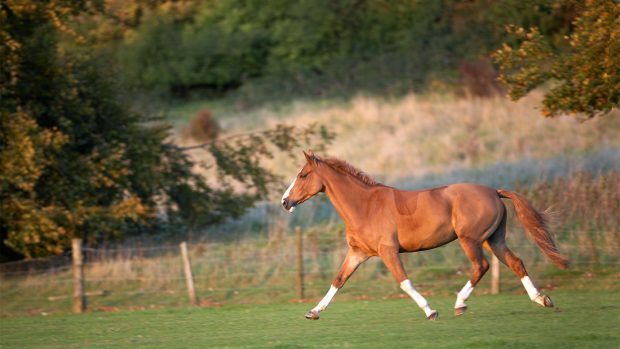The condition osteochondrosis dissecans in horses, also know as OCD in horses, is self-limiting in some cases and crippling for others, yet a series of uncertainties makes identifying the problem, deciding on treatment options and providing an accurate prognosis far from straightforward.
What is OCD in horses?
The developmental orthopaedic disease that is correctly termed osteochondrosis dissecans starts before a foal is a year old and can lead to several different bone and joint problems in later life.
Problems begin within the first 12 months of development, as the foal’s growing skeleton matures. Essentially soft cartilage cells are converted to more solid bone by a process known as endochondral ossification.
In OCD-affected animals, this natural process fails to function fully. Areas of damaged cartilage develop within the joint, leaving the underlying bone weak and prone to further injury.
Continuing cartilage and bone growth means that some defects may heal before the foal is a year old. Once a foal has matured to a yearling and beyond, however, the transformation from cartilage to bone stops and there is minimal scope for natural healing to occur.
Any loose flaps or fragments of cartilage that are not properly attached will cause irritation, inflammation and consequent swelling of the affected joint. The whole syndrome is called osteochondrosis, with dissecans referring to these fragments.
Signs of OCD in horses
The most obvious sign is an enlarged joint, swollen with extra joint fluid due to inflammation.
A bog spavin, which is a distended main hock joint, is most commonly recognised. While this may not necessarily be as bad as it looks, it’s best to have it checked out. Other less obviously swollen joints may be more of a potential problem, particularly the stifles and all four fetlocks.
Lameness may be present, but can vary in degree from day to day. Other signs include an awkward stance, reduced activity or unusual stiffness and poor impulsion. The horse may be reluctant or struggle to get up after lying down.
OCD in horses: diagnosis and treatment
Diagnosis can be made based on the clinical signs, but these may be subtle and X-rays are usually necessary to confirm the condition.
X-rays only show bone clearly, however, not cartilage. Keyhole surgery (arthroscopy) is sometimes required to assess the degree of damage within the joint and to enable removal of damaging fragments.
While such surgery can be very successful, it is debatable whether it is always necessary — especially if the horse is not actually lame.
In foals less than a year old, the disease has a relatively dynamic nature. Changes within a joint may develop or regress spontaneously. Some affected foals respond very well to a period of rest, together with an appropriately balanced diet.
One particularly challenging aspect of OCD is that it may be clinically “silent”. The condition may only be discovered in the older horse, for example, during a pre-purchase X-ray examination.
This can lead to some difficult decision-making. Electing to submit a sound horse to surgery can be tough but, if you do not, will it remain sound? Is it reasonable to complete the purchase?
As a vet, it is hard to provide accurate advice to enable purchasers to proceed with the least risk. The decision depends on many factors, particularly the horse’s performance record and the location of the OCD.
There is also an argument that lameness is a greater risk in the older horse with undiagnosed or ignored OCD problems, since long-term inflammation in joints can potentially cause arthritis.
The choice of treatment therefore depends on a variety of factors, including the degree of lameness and the location and severity of the OCD. The age of the horse and its intended use must also be considered.
There is no simple answer for many of these cases, so it makes sense to discuss all the options with an equine orthopaedic specialist. Surgical advances and joint medication have certainly helped manage OCD in individual horses.
The full veterinary article about OCD was first published in Horse & Hound magazine (16 May 2013)



